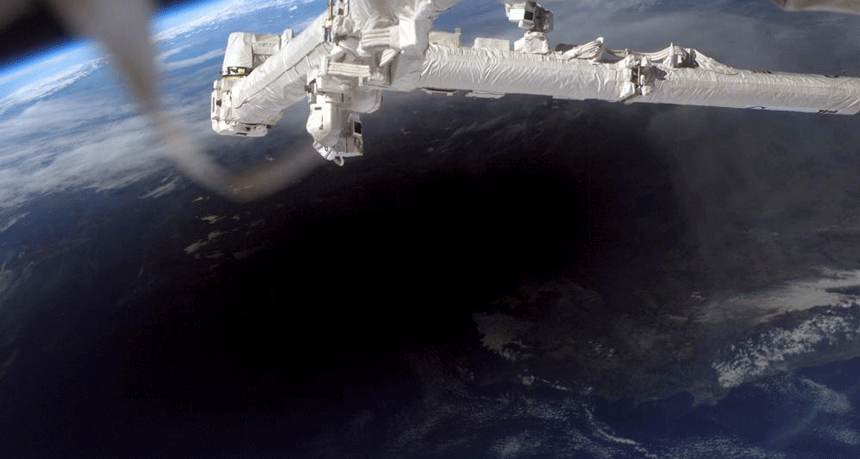Citizen scientists wanted to make an eclipse megamovie
Contribute to scientific research by filming some footage during the August 2017 eclipse

The International Space Station got to view the shadow of the moon as it moved across the Earth during a 2008 solar eclipse.
NASA
On August 21, 2017, a narrow swath of the United States will experience night in the middle of the day. That darkness will come from a total solar eclipse. The moon will pass in front of the sun, casting its shadow on Earth. The moon’s shadow will travel across the country, from Oregon to South Carolina. And anyone in the shadow’s path will be able to help scientists study the moon and sun. All they’ll need is a camera or smartphone.
Scientists need volunteers to turn film-maker for the Eclipse Megamovie Project. Researchers at the University of California, Berkeley, the Google Making and Science Initiative and elsewhere are running the project. They will combine videos and images from more than 1,000 people across the United States into two movies. These 90-minute “megamovies” will show the solar eclipse as it moves across the continent.
The project is recruiting two groups of volunteers. Some 400 will come from amateur astronomy groups. These citizen scientists will set up digital single lens reflex (DSLR) cameras under the path of the eclipse. Each camera will need a lens to zoom in and a tripod to hold the equipment steady. The volunteers will also need to be able to record their exact position and time using a GPS device. (GPS is short for global positioning system.) A training session will teach the volunteers how to upload their data properly. That data will be used to make the first megamovie.
But not everyone needs so much equipment. The second megamovie will be made with data from volunteers equipped with a smartphone app that is in development. The app will guide the volunteers in taking carefully timed photos of the eclipse with their smartphones.
Both films will be useful for scientists. Eclipses can be used to study the sun’s corona — the sun’s outer atmosphere. Normally, the glare from the rest of the sun prevents an easy view of the corona from Earth. But when the moon passes in front and blocks most of the sun’s light, the corona is easier to view.
Flashes of light will occur as the moon moves in front of the sun. As the sun peeks out behind the moon, it will highlight some of the moon’s features. Scientists can use images taken during this time to learn more about the moon’s surface.
Volunteers need to sign up at the project’s website. But only those directly under the path of the eclipse can participate. Those from states like California, Maine and Texas need not apply. The data will be public, however, so anyone can study it.
If you are looking up that day, make sure to view the eclipse safely. Staring directly at the sun is dangerous — except for the brief time when it is completely covered by the moon.
But if you’re going to be stuck outside the path of the eclipse, don’t worry! You can still see something. The National Eclipse Ballooning Project will be sending up weather balloons that will send back live video of the event.
Follow Eureka! Lab on Twitter







